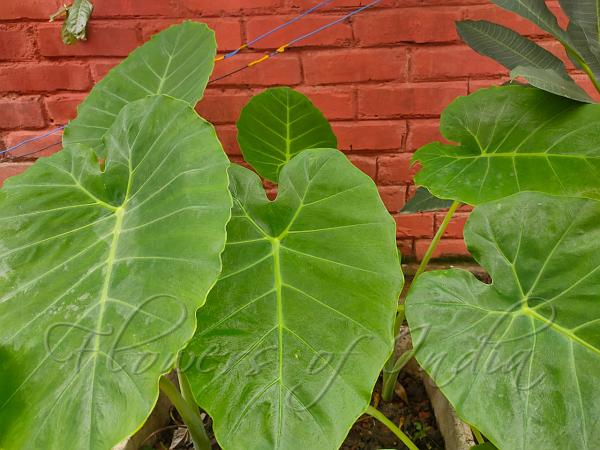|
| Indian Taro |
|

|

| File size | 544425 |
| Original date | 7/18/25 4:17 PM |
| Resolution | 320 x 240 |
| Flash | Flash did not fire, auto |
| Focal length | 4.74mm |
| Exposure time | 1/33s |
| Aperture | 1.79 |
| Focus Distance | |
| Metering Mode | Average |
| Camera make | Xiaomi |
| Camera model | Redmi Note 10 Lite |
| Sensor type | MonochromeArea |
|
|
|
|
Photo: |
Botanical name: Alocasia indica Family: Araceae (Arum family)
Synonyms: Arum indicum, Colocasia indica
Synonyms: Arum indicum, Colocasia indica
Indian Taro is a perennial herb that has long been
botanically confused with
Giant Taro. However, for people of
Manipur the two are distinctly different - Indian Taro is an edible plant,
whereas Giant Taro is generally not consumed. Leaves are broad, light green in
color, slightly heart-shaped, margin entire and wavy, two ovoid lobes
at the base are rounded, tip is a also very much rounded. On the other
hand, the large leaves of Giant Taro are prominently arrow-shaped. Midrib,
primary and secondary veins are slightly whitish (not distinct), leaf-stalk
long, fleshy, porous, overlap with one another, produce watery sap, sheathing
at the lower part. Inflorescence is a spadix, spadix surrounded by a
spathe and shorter than spathe, pale yellow. Fruit is a fleshy berry,
spherical when mature. The leaf-stalk along with the leaf is commonly
cooked and consumed whereas the corm is commonly consumed fresh,
in spicy salad known as Singju. Indian Taro is widely cultivated
in Manipur. It is native to the Indian Subcontinent to Indo-China.
Medicinal uses: It is believed that this
species is rich in iron content and so the cooked
leaf-stalk is given during post-delivery of child birth which helps in
the
faster recovery. The leaf blade is slightly roasted on fire directly
and applied
externally to reduce boils and swellings.
It is believed that this
species is rich in iron content and so the cooked
leaf-stalk is given during post-delivery of child birth which helps in
the
faster recovery. The leaf blade is slightly roasted on fire directly
and applied
externally to reduce boils and swellings.
Medicinal uses:
 It is believed that this
species is rich in iron content and so the cooked
leaf-stalk is given during post-delivery of child birth which helps in
the
faster recovery. The leaf blade is slightly roasted on fire directly
and applied
externally to reduce boils and swellings.
It is believed that this
species is rich in iron content and so the cooked
leaf-stalk is given during post-delivery of child birth which helps in
the
faster recovery. The leaf blade is slightly roasted on fire directly
and applied
externally to reduce boils and swellings. | Identification credit: Tabish | Photographed in Imphal, Manipur. |
• Is this flower misidentified? If yes,